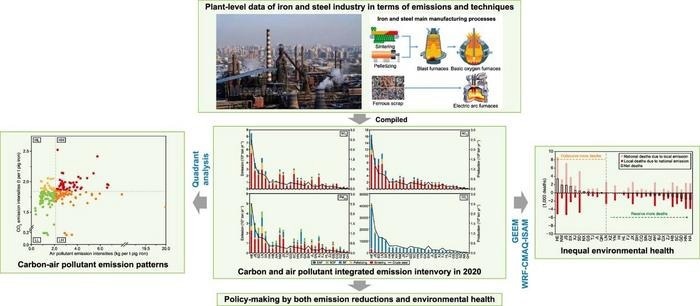China, the biggest steel manufacturer in the world, must simultaneously address climate change mitigation and air quality improvement. Recent research provided a thorough examination of the risks to environmental health and CO2 emissions associated with China's iron and steel industry (ISI). This study provides a roadmap for a sustainable transition that is essential for reducing global warming and enhancing air quality.
 Graphical abstract. Image Credit: Environmental Science and Ecotechnology
Graphical abstract. Image Credit: Environmental Science and Ecotechnology
The iron and steel sector in China, which contributes significantly to pollution and CO2 emissions, has put the country at a crossroads and highlights the urgent need for greener methods. China is the world's largest producer of steel.
The requirement is a result of the industry’s influence on air quality and climate change worldwide, which is fueling the movement to embrace low-emission and sustainable technology to guarantee environmental preservation and compliance with international climate agreements.
In a recent study (doi: 10.1016/j.ese.2023.100367), experts from the Chinese Academy of Environmental Planning provide a thorough analysis of the health effects and CO2 emissions from China’s iron and steel industry.
The study was published in Volume 20 of the journal Environmental Science and Ecotechnology. Underscoring the urgent need for environmentally friendly modifications, the study lays forth a viable transformation plan to mitigate climate change and improve air quality.
The study thoroughly examines the health effects and CO2 emissions associated with China’s iron and steel sector, identifying blast furnaces and sintering operations as the primary sources of pollution.
It reveals the harsh truth of how these emissions increase PM2.5 concentrations, causing serious health consequences, including tens of thousands of premature deaths yearly, through a painstakingly constructed emission inventory of 811 companies. Proposing a transition to sophisticated, energy-efficient production technology, the study establishes a strategic plan for the industry.
Highlights
- The primary source of air pollution is sintering, and 81% of CO2 emissions come from blast furnaces.
- In China, ISI is predicted to result in more than 59,000 preventable deaths by 2020.
- The emissions from Hebei, Jiangsu, Shandong, Shanxi, and Nei Mongol are responsible for 48% of PM2.5-related mortality.
- Provinces with significant carbon emissions and health impacts ought to impose more stringent regulations.
We have identified key areas where intervention can significantly reduce environmental and health impacts. By focusing on energy-efficient technologies and advanced techniques, along with ultra-low emission standards, we can pave the way for a sustainable future for the iron and steel industry.
Dr. Wenbo Xue, Study Lead Researcher, State Environmental Protection Key Laboratory of Environmental Pollution and Greenhouse Gases Co-control, Chinese Academy of Environmental Planning
The industry’s sustainable transition is one big step closer with this report. Policymakers and stakeholders can utilize it as a useful resource since it emphasizes the significance of coordinated efforts to reduce pollution and carbon emissions to create a healthier and more environmentally friendly future.
Journal Reference:
Wu, W., et. al. (2024) Quantifying China’s iron and steel industry’s CO2 emissions and environmental health burdens: A pathway to sustainable transformation. Environmental Science and Ecotechnology. doi:10.1016/j.ese.2023.100367